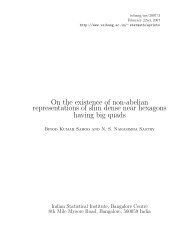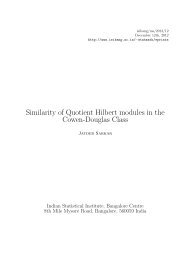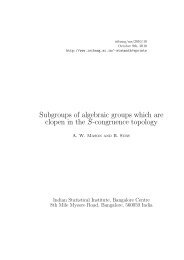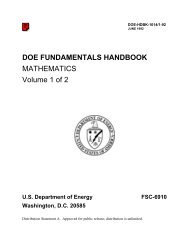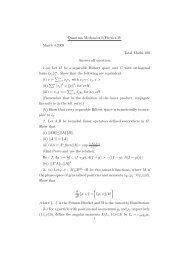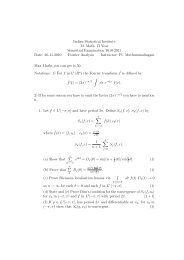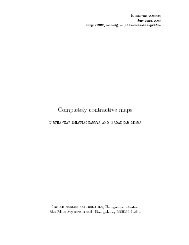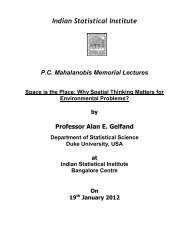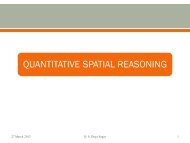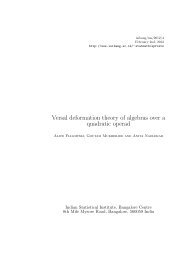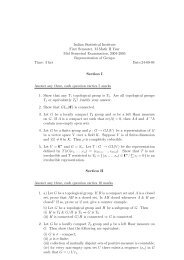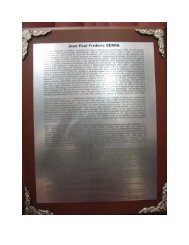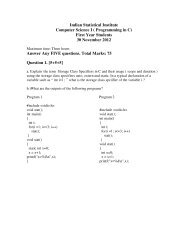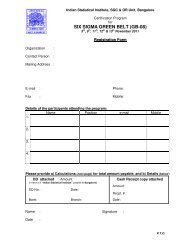Cyclotomy and cyclotomic polynomials - Indian Statistical Institute
Cyclotomy and cyclotomic polynomials - Indian Statistical Institute
Cyclotomy and cyclotomic polynomials - Indian Statistical Institute
Create successful ePaper yourself
Turn your PDF publications into a flip-book with our unique Google optimized e-Paper software.
GENERAL ] ARTICLE<br />
<strong>Cyclotomy</strong> <strong>and</strong> Cyclotomic Polynomials<br />
The Story of how Gauss Narrowly Missed Becoming a Philologist<br />
B Sury<br />
<strong>Cyclotomy</strong> - literally circle-cutting - was a puzzle beguu<br />
more than 2000 years ago by the Greek geometers. In this<br />
pastime, they used two implements - a ruler to draw straight<br />
lines <strong>and</strong> a compass to draw circles. The problem of cyclotomy<br />
was to divide the circumference of a circle into n equal<br />
parts using only these two implements.<br />
As these n points on the circle are also the corners of a<br />
regular n-gon, the problem of cyclotomy is equivalent to<br />
the problem of constructing the regular n-gon using only a<br />
ruler <strong>and</strong> a compass. Euclid's school constructed the equilateral<br />
triangle, the square, the regular pentagon <strong>and</strong> the<br />
regular hexagon. For more than 2000 years mathematicians<br />
had been unanimous in their view that for no prime p bigger<br />
than 5 can the p-gon be constructed by ruler <strong>and</strong> compasses.<br />
The teenager Carl Friedrich Gauss proved a month before<br />
he was 19 that the regular 17-gon is constructible. He did<br />
not stop there but went ahead to completely characterise all<br />
those n for which the regular n-gon is constructible! This<br />
achievement of Gauss is one of the most surprising discoveries<br />
in mathematics. This feat was responsible for Gauss<br />
dedicating his life to the study of mathematics instead of<br />
philology 1 in which too he was equally proficient.<br />
In his mathematical diary 2 maintained from 1796 to 1814,<br />
he made his first entry on the 30th of March <strong>and</strong> announced<br />
the construction of the regular 17-gon. It is said that he<br />
was so proud of this discovery that he requested that the<br />
regular 17-gon be engraved on his tombstone! This wish was,<br />
however, not carried out.<br />
An amusing story alludes to K~istner, one of his teachers at<br />
the university of Gottingen, <strong>and</strong> an amateur poet. When<br />
Gauss told him of his discovery, K~istner was skeptical <strong>and</strong><br />
B Sury is with the <strong>Indian</strong><br />
<strong>Statistical</strong> <strong>Institute</strong> in<br />
Bangalore .<br />
By 18, Gauss was already an<br />
expert in Greek, Latin, French<br />
<strong>and</strong> German. At the age of 62,<br />
he took up the study of Russian<br />
<strong>and</strong> read Pushkin in the origi-<br />
nal.<br />
2 The diary was found only in<br />
1898!<br />
RESONANCE I December 1999 41
GENERAL<br />
I ARTICLE<br />
did not take him seriously. Gauss insisted that he could<br />
prove his result by reducing to smaller degree equations <strong>and</strong>,<br />
being fond of calculations, also showed the co-ordinates of<br />
the 17 points computed to several decimal places. Kiistner<br />
is said to have claimed that he already knew such approximations<br />
long before. In retaliation, some time later, Gauss<br />
described Kiistner as the best poet among mathematicians<br />
<strong>and</strong> the best mathelnatician among poets!<br />
Gauss's proof was not only instrumental in making up his<br />
mind to take up mathematics as a career but it is also the<br />
first instance when a mathematical problem from one domain<br />
was rephrased in another domain <strong>and</strong> solved successfully.<br />
In tiffs instance, the geometrical problem of cyclotomy<br />
was reset in algebraic terms <strong>and</strong> solved. So, let us see more<br />
in detail what cyclotomy is all about.<br />
a It is understood that the cen-<br />
tre is also given.<br />
The unit circle is given to us a <strong>and</strong> we would like to divide<br />
it into n equal parts using only the ruler <strong>and</strong> compass. It<br />
should be noted that the ruler can be used only to draw a<br />
line joining two given points <strong>and</strong> not for measuring lengths.<br />
For this reason, one sometimes uses the word straightedge<br />
instead of a ruler.<br />
If we view the plane as the complex plane, the unit circle has<br />
the equation z = e i~ Since arc length is proportional to the<br />
27r i k<br />
angle subtended, the n complex numbers e - , 1 < k < ~<br />
cut the circumference into n equal parts.<br />
As we might fix a diameter to be the x-axis, the problem<br />
may also be variously posed as the problem of using only<br />
the ruler <strong>and</strong> the compass to:<br />
(i) find the roots of z" = 1, or<br />
(ii) construct the angle ~.<br />
Since, by coordinate geometry, a line <strong>and</strong> a circle have equations,<br />
respectively, of the form ax+by = c <strong>and</strong> (x- s)2+ (~/-<br />
t) 2 = r 2, their points of intersection (if any) are the common<br />
roots. Eliminating one of x, y leads to a quadratic equation<br />
for the other. Therefore, the use of ruler <strong>and</strong> compasses<br />
amounts in algebraic terms to solving a chain of quadratic<br />
42 RESONANCE I December 1999
GENERAL<br />
I ARTICLE<br />
equations.<br />
Before we go further, we need to clarify one point. On the<br />
one h<strong>and</strong>, we seem to be talking of constructing lengths <strong>and</strong>,<br />
on the other h<strong>and</strong>, we seem to want to mark off certain specific<br />
points on the plane corresponding to the vertices of the<br />
~,-gon. To remove any confusion due to this, let us explain<br />
how these are equivalent. The reader is encouraged to consult<br />
Chapter la of the undergraduate text [1] for additional<br />
material.<br />
Figure 1 (left).<br />
Figure 2 (right).<br />
Some Easy Constructions Possible with a Ruler <strong>and</strong><br />
a Compass<br />
1. Drop a perpendicular on a given line 1 from a point P<br />
outside it (Figure 1). Draw a circle centred at P cutting 1 at<br />
A <strong>and</strong> B. Draw circles centred at A <strong>and</strong> B having radii AP<br />
<strong>and</strong> BP, respectively. The latter circles intersect at P <strong>and</strong><br />
Q <strong>and</strong> PQ is perpendicular to 1.<br />
2. Draw a perpendicular to a given line 1 through a point P<br />
on it (Fig~Lre 2). Draw any circle centred at P intersecting 1<br />
at A <strong>and</strong> B. Then, the circles centred at A <strong>and</strong> B with the<br />
common radius AB intersect at two points C <strong>and</strong> D. Then,<br />
CD passes through P <strong>and</strong> is perpendicular to 1.<br />
3. Draw a line parallel to a given line through a point outside.This<br />
follows by doing the above two constructions in<br />
succession.<br />
RESONANCE J December 1999 43
A<br />
T<br />
GENERAL<br />
I ARTICLE<br />
Figure 3.<br />
4. Bisect a given segment AB.This is obvious from Figure 2.<br />
The circles centred at A <strong>and</strong> B having the common radius<br />
AB intersect at two points. The line joining these two points<br />
is the perpendicular bisector.<br />
Mar~:ing the point (a,b) on the plane is, by these observa-<br />
tions, equivalent to the construction of the lengths l a I <strong>and</strong><br />
I b l. Further, one can view the same as the construction of<br />
the complex number a + ib.<br />
5. If a <strong>and</strong> b are constructed real numbers, then the roots<br />
of the polynomial x 2 - ax + b = 0 are constructible as well.<br />
Actually, in the discussion of cyclotomy, we will need to<br />
deal only with the case when the roots of such a quadratic<br />
equation are real. In this case, (Figure 3) draw the circle<br />
with the segment joining the points (0, 1) <strong>and</strong> (a, b) as its<br />
diameter. The points of intersection of this circle with tile x-<br />
axis are the roots a+C~=~-4b of the given quadratic equation<br />
2<br />
x 2 - ax + b = O.<br />
Even when the roots of x 2 - ax + b = 0 are not real, they<br />
can be constructed easily. In this case, we need to construct<br />
the points (a ~ ) <strong>and</strong> (~ - 2v+~) But, as we oh-<br />
2, ~ "<br />
served earlier, we can drop perpendiculars <strong>and</strong> it suffices to<br />
construct the absolute value of these roots which is yZ-b. This<br />
44<br />
RESONANCE I December 1999
GENERAL<br />
J ARTICLE<br />
is accomplished by drawing the circle with the segment joining<br />
(0, 1) <strong>and</strong> (0, -b) as diameter <strong>and</strong> noting that it meets<br />
the x-axis at the points (v/-b, 0) <strong>and</strong> (-x/b, 0).<br />
With this renewed knowledge, let us return to cyclotomy.<br />
For ~ -- 2, one needs to draw a diameter <strong>and</strong> this is evidently<br />
achieved by the ruler.<br />
For n = 3, the equation-z 3 - 1 -- 0 reduces to the equations<br />
--lq-iy~<br />
z-l=Oorz2+z+l=O. The roots of the latter are 2<br />
So, we have to bisect the segment [-1, 0] <strong>and</strong> the points of<br />
intersection of this bisector with the unit circle (Figure 4)<br />
are the points we want to mark off on the circle.<br />
For ~ = 4, again only bisection (of the x-axis) is involved.<br />
This already demonstrates clearly that if the regular n-gon<br />
can be constructed, then so can the 2rn-gon for any r. In<br />
particular, the 2r-gons are constructible.<br />
To construct the regular pentagon, one has to construct the<br />
roots of z 5 - 1 = 0. These are the 5-th roots of unity 4k; i <<br />
2~ri<br />
A: < 5 where ~ = e-~-. Now the sum of the roots of z 5 - 1 is<br />
0-- ~+C 2+43+44+45 . On using this <strong>and</strong> the fact that<br />
45 = 1, we get (42+43)(4+44 ) = 4+42+43+44 = -1. On the<br />
other h<strong>and</strong>, we also have their sum (42 + 43) + (4 + 44) = - 1.<br />
This means that C2 + (3 <strong>and</strong> ( + (4 are the two roots of the<br />
quadratic polynomial T 2 + T - 1 = 0. Thus, r + 4 4 (being<br />
Figure 4.<br />
RESONANCE I December 1999 45
GENERAL<br />
J ARTICLE<br />
positive) equals -1+~ 2 Multiplying this equality by r <strong>and</strong><br />
using ~5 __ 1, one gets a quadratic equation for r ! This is<br />
the algebraic reasoning behind the construction. Following<br />
it, we can geometrically make the construction also with the<br />
aid of the dictionary between algebra <strong>and</strong> geometry that we<br />
have established above.<br />
Let us now turn to the construction of the 17-gon. There are<br />
many ways of doing it - [2], [3] contain explicit geometric<br />
algorithms; Gauss's own appears in [4, Art.365] - <strong>and</strong> all<br />
of them succeed essentially because 17 - 1 is a power of<br />
X17--1<br />
2! This is the reason why the degree 16 equation x-1 -<br />
x 16 § x 15 + ... § x § 1 = 0 reduces to a chain of quadratic<br />
equations.<br />
4 Perhaps, an outst<strong>and</strong>ing fea-<br />
ture of mathematics is that<br />
knowing the conceptual reason<br />
behind a phenomenon is often<br />
much more important than a<br />
proof of the phenomenon itself.<br />
It would be ideal to use the language of Galois theory (see<br />
Resonance, Vol. 4, No. 10,1999) to discuss the constructibility<br />
or nonconstructibility of a regular polygon. However, we<br />
will keep the discussion elementary <strong>and</strong> will only make a few<br />
remarks for the reader familiar with basic Galois theory so<br />
that she/he can grasp the conceptual reason behind various<br />
explicit expressions, the appearance of which will seem magical<br />
without the added underst<strong>and</strong>ing 4 provided by Galois<br />
theory.<br />
In the light of our dictionary, we describe a construction as<br />
follows:<br />
2~.~ r<br />
Denote by ~, the 17-th root of unity e~-. Then, -- 1<br />
gives C16+r ...+r = 0. Let us write al,aa, a3 for the<br />
three real numbers r + ~-3 + r + r + r + r + r + r<br />
~3 + r + r § r <strong>and</strong>, r + r respectively. Look at the<br />
sequence of four quadratic equations:<br />
T 2-(~3T+ 1 =0,<br />
T 2- ~3_6~2_2~1+1<br />
2<br />
T 2-niT- 1 =0,<br />
T2-T-4_--0.<br />
T+~2=0,<br />
A routine calculation shows that r a3, a2, al are roots of the<br />
four equations in that order. The roots of the last equation<br />
46 RESONANCE I December 1999
GENERAL I ARTICLE<br />
are evidently constructible as it has integer coefficients. This<br />
means that one can construct ( by recursively constructing<br />
the roots of these equations using a ruler <strong>and</strong> a compass. The<br />
reader may geometrically make the construction based on<br />
the dictionary above or consult one of the references quoted.<br />
The reader familiar with basic Galois theory would recall<br />
that the four successive quadratic extension fields generated<br />
by the <strong>polynomials</strong> give a tower of corresponding Galois<br />
groups. Tile Galois group of the <strong>cyclotomic</strong> field 5 Q(()<br />
over Q is a cyclic group of order 16 generated by the automorphism<br />
a : r ~ (3 (in other words, 3 is a primitive root<br />
modulo 17). The automorphisms a 2, a 4 <strong>and</strong> a s fix al, c~2<br />
<strong>and</strong> a3, respectively.<br />
s This is the field consisting of<br />
all rational polynomial expressions<br />
in ~.<br />
Now, the question remains as to what made this work <strong>and</strong><br />
which other n-gons are constructible. Look at the regular<br />
~-gon for some n. To construct it, one needs to mark off the<br />
2~rl<br />
complex number ( = e--~-. The question is whether ( can<br />
be expressed in terms of a nested chain of square roots. For<br />
example, for the 17-gon, one gets<br />
27r 1 ~6x/~ 1 4<br />
Cos = - + + T~ V/(3 - 2v~)<br />
Of course, ( is a root of the polynomial z n - 1 = 0. But, it is<br />
a root of an equation of smaller degree. What is the smallest<br />
degree equation of which ( is a root? Not only is there<br />
such a monic 6 polynomial but by the division algorithm,<br />
this polynomial is unique <strong>and</strong> divides any other polynomial<br />
of which ( is a root. This polynomial is called a <strong>cyclotomic</strong><br />
polynomial. The degree of this polynomial is of paramount<br />
importance because if it is a power of two, we know from<br />
our earlier discussion that ( can be constructed. The <strong>cyclotomic</strong><br />
<strong>polynomials</strong> are useful in many ways <strong>and</strong> have several<br />
interesting properties some of which will be discussed in the<br />
last three sections.<br />
6 Manic means that the top co-<br />
efficient is 1.<br />
For a prime number p such that p- 1 is a power of 2, our dis-<br />
RESONANCE J December 1999 47
GENERAL<br />
J ARTICLE<br />
cussion shows that the regular p-gon is constructible. Such<br />
a prime p is necessarily of the form 22n + 1 since 2 ~ + 1<br />
is always a multiple of 3. Fermat thought that the numbers<br />
22"+ 1 are primes for all n. However, the only primes<br />
of this form found until now are 3, 5, 17, 257 <strong>and</strong> 65537(!)<br />
The number 225 + 1 was shown by Euler to have 641 as a<br />
proper factor. For coprime numbers m. <strong>and</strong> n, if the m-<br />
gon <strong>and</strong> the n-gon are constructible, then so is the rnn-gon.<br />
The reason is, if we write ma + nb = 1 for integers a,b,<br />
then Cos(~) = Cos(~ + 2~_~a) which is constructible when<br />
Cos(2~t') m <strong>and</strong> Cos (,--~7, 2~a ) are. Thus, Gauss's analysis shows<br />
that if n is a product of Fermat primes <strong>and</strong> a power of 2,<br />
the regular n-gon can be constructed by a ruler <strong>and</strong> a com.-<br />
pass. The converse is also true i.e. if the regular n-gon is<br />
constructible, then n is of this special form. Gauss did not<br />
give a proof of this although he asserted it to be true; see<br />
[5]. The construction of the regular 257-gon was published<br />
in four parts in Crelle's Journal. Details of the 65537-gon<br />
fill a whole trunk kept at the University of GSttingen !<br />
We must see Gauss's feat in the light of the fact that complex<br />
analysis was in its infancy at that time. In fact, Gauss was<br />
the first one to give a rigorous proof (in his doctoral thesis) of<br />
the so-called fundamental theorem of algebra which asserts<br />
that every nonconstant complex polynomial has a root.<br />
Abel's Theorem for the Lemniscate<br />
Abel earned fame by proving that the general equation of<br />
degree at least five is not solvable by a 'formula' involving<br />
only square roots, cube roots <strong>and</strong> higher roots. One of his<br />
lesser-known achievements involves a problem analogous to<br />
cyclotomy viz., the division of the lenmiscate. The name<br />
lemniscate literally means a ribbon <strong>and</strong> comes from its shape<br />
(Figure 5); this curve - also called the elastic curve - was<br />
discovered by Bernoulli.<br />
Figure 5.<br />
48 RESONANCE I December 1999
GENERAL<br />
I ARTICLE<br />
It has an equation of the form (x 2 + y2)2 = x 2 _ y2. The<br />
total arc length of the lemniscate is given by the integral<br />
4 fl v/~. dt Thus, the number ~ which is half of this in-<br />
tegral is the analogue of ~r for the unit circle. It is approximately<br />
2.6205... Gauss had already asserted as entry 62 in<br />
his diary (see [6]) that the lemniscate is divisible into five<br />
equal parts by a ruler <strong>and</strong> a compass. The previous two<br />
entries show clearly that Gauss knew that the lemniscatic<br />
trigonometric functions are doubly-periodic functions; they<br />
are called elliptic functions nowadays. He hinted at a vast<br />
theory of his behind these functions but this work never appeared.<br />
It was Abel who published a comprehensive treatise<br />
on elliptic functions <strong>and</strong> in it he also looked at the problem<br />
of' dividing the lemniscate into 77, equal parts for any 77,<br />
(see [7] for a more modern discussion). He discovered the<br />
remarkable fact that the answer is the same as for the circle!<br />
In other words, the lemniscate can be divided into 77, equal<br />
parts with the aid of a ruler <strong>and</strong> a compass if, aad only if, n<br />
is a product of a power of 2 <strong>and</strong> distinct Fermat primes. The<br />
reason can again be understood using Galois theory. In the<br />
case of the circle, the Galois group of the <strong>cyclotomic</strong> extension<br />
is the multiplicative group of integers modulo n which<br />
are coprime to n. This latter group is a group of order a<br />
power of 2 exactly when n is as above. For the lemniscate,<br />
it turns out that one needs to know when the unit group of<br />
Z [i]/nZ [i] is a group of order a power of 2 where the set Z [i]<br />
of Gaussian integers consists of the complex numbers a + bi<br />
with integral a, b.<br />
Cyclotomic Polynomials<br />
We introduced for any positive integer n, the <strong>cyclotomic</strong><br />
polynomial. On(X) as the unique monic integer polynomial<br />
2~ri<br />
of least degree having ( = e-a- as a root. What does O,,(X)<br />
look like ? Obviously 01(X) = X - 1 <strong>and</strong> O2(X) = X + 1.<br />
Moreover, for a prime number p, Op(X) = X p-1 + X p-2 +<br />
9 .. + X + 1. For any n, the n-th roots of unity are the<br />
2~'ir<br />
complex numberse -, ;l
GENERAL<br />
I ARTICLE<br />
of ~.(x)! So, x',-1 = [Iel. yI(r,..):,~.(x- r r) = 1-Iel. ~d(x).<br />
Here, we have denoted by (r, n) the greatest common divisor<br />
of r <strong>and</strong> ,. From the above expression for 'I),.(X), it is not<br />
at all clear that (I),,(X) has integer coefficients. However,<br />
one uses elementary number theory to invert the identity<br />
X"-I = 1-I(~1,, (I)a(X). This is known as the MSbius inversion<br />
formula <strong>and</strong> yields the identity (I),,(X) = 1-Idl,, (X d _ 1)#(n/d)<br />
where the MSbius flmction #(m) is defined to take the value<br />
0, 1 or -1 according as whether m is divisible by a square,<br />
is a square-free product of an even number of primes, or<br />
is a square-free product of an odd number of primes. The<br />
inversion formula is a very easy <strong>and</strong> pleasant exercise in<br />
elementary number theory. Now, from the above expression,<br />
it is not clear that the fl'actional expression on the right side<br />
is indeed a polynomial! But, this follows from induction on<br />
n once we recall the expression X"- 1 = I-ldJ,, ~d(X).<br />
An interesting feature of the <strong>cyclotomic</strong> <strong>polynomials</strong> is the<br />
following. The coefficients seem to be among 0, 1 <strong>and</strong> -1 -<br />
fbr instance, for a prime p, ~p(X) = 1 + X + ... + X "-1 -<br />
<strong>and</strong> one might wonder whether this is true for any (I),.(X).<br />
It turns out that (I)105 has one coefficient equal to 2! Using,<br />
some noni:rivial results on how prime numbers are distributed,<br />
one can show that every integer occurs among the<br />
coefficients of the <strong>cyclotomic</strong> <strong>polynomials</strong>[<br />
Infinitude of Primes ending in 1<br />
11, 31,41, 61, 71,101,..- where does it stop? Are there infinitely<br />
many primes ending in 1 ? Equivalently, does the<br />
arithmetic progression {1 + 10n;n >_ 1} contain infinitely<br />
many primes? Any prime number other than 2 must obviously<br />
end in 1, 3, 7 or 9. The natural question is whether<br />
there are infinitely many of each type? The answer is 'yes'<br />
by a deep theorem due to Dirichtet - infinitely many primes<br />
occur in any arithmetic progression {a + nd;n > O} with<br />
a, d coprime. For an arithmetic progression of the form<br />
{1 + nd;n > O} for some natural number d, one can use<br />
<strong>cyclotomic</strong> <strong>polynomials</strong> to prove this! This is not surprising<br />
because we have already noted in the last section that <strong>cyclotomic</strong><br />
<strong>polynomials</strong> are related to the way prime numbers<br />
50<br />
RESONANCE { December 1999
GENERAL<br />
J ARTICLE<br />
are distributed.<br />
Suppose pl,p2,'",pr are prime numbers in this progression.<br />
We will use <strong>cyclotomic</strong> <strong>polynomials</strong> to produce another<br />
prime p in this progression different from the pi's. This<br />
would imply that there are infinitely many primes in such a<br />
progression. Consider the number N = dplP2""pr. Then,<br />
for any integer n, the two values r <strong>and</strong> ~d(0) are equal<br />
modulo N. But, Od(0) is an integer which is also a root of<br />
unity <strong>and</strong> must, therefore, be +1. Moreover, as n --+ oo,<br />
the values ~d(nN) ---+ oo as well. In other words, for large<br />
n, ~d(nN), is different from +1 <strong>and</strong> therefore, has a prime<br />
factor p. We note that as ~d(nN) is +1 modulo any of the<br />
p,:'s or modulo d, any prime factor p of it is different from<br />
d as well as from any of the pi's. One might wonder which<br />
primes divide some value gPd(a) of a <strong>cyclotomic</strong> polynomial.<br />
The answer is that these are precisely the primes occurring<br />
in the arithmetic progression {1 +nd; n > 0}: To show this,<br />
we use the idea that the nonzero integers modulo p form a<br />
group of order p - 1 under the multiplication modulo p. So,<br />
it is enough to prove that if p divides ~d(a) for some integer<br />
a, then a has order d modulo p i.e., p divides a d - 1 <strong>and</strong> d is<br />
minimal. Let us prove this now. Since X d- 1 = 1-Itld~Z(X),<br />
it follows that p which divides Od(a) has to divide a d- 1.<br />
If d were not minimal, let k divide d with k < d <strong>and</strong> p divides<br />
a k - 1. Once again, the relation a k - 1 = 1-Illk ~Pl(a)<br />
shows that p divides OL(a) for some 1 dividing k. Therefore,<br />
p divides both Od(a +p) <strong>and</strong> ~l(a +p).S Now,<br />
(a+p)d--1 = 1-I ~m(a+p) = ~d(a+p)~l(aWp)" (other factors<br />
rn.ld<br />
the expression on the right h<strong>and</strong> side is divisible by p2. On<br />
the other h<strong>and</strong>, the left side is, modulo p2, equal to ad--} -<br />
dpa d-1 - 1. Since p2 divides a d - 1, it must divide dpa d-1<br />
as well. This is clearly impossible since neither a nor d<br />
is divisible by p. This proves that any prime factor p of<br />
#Pd(nN) occurs in the arithmetic progression {1 + nd;n ><br />
0} <strong>and</strong> thereby proves the infinitude of the primes in this<br />
progression.<br />
Euclid's classical proof of the infinitude of prime numbers is<br />
8 For any polynomial P (A'), the<br />
values P (a+p) <strong>and</strong> P (a) are<br />
equal modulo p.<br />
RESONANCE I December 1999 51
GENERAL I ARTICLE<br />
the special case of the above proof where we can use d = 2.<br />
Sum of Primitive Roots<br />
For a prime number p, Gauss defined a primitive root modulo<br />
p to be an integer a whose order modulo p is p - 1. In<br />
other words, a is a generator of the multiplicative group of<br />
integers modulo p. He also showed that primitive roots modulo<br />
n exist if, <strong>and</strong> only if, n is 2, 4, pa or 2p ~ for some odd<br />
prime p. For instance, the primitive roots modulo 5 among<br />
the integers modulo 5 are 2 <strong>and</strong> 3. Their sum is 0 modulo 5.<br />
Now, look at the integers modulo 7. In this case, the primitive<br />
roots are 3 <strong>and</strong> 5. Modulo 7, these sum to 1. What<br />
about 11? The primitive roots here are 2,6,7 <strong>and</strong> 8 <strong>and</strong><br />
these give the sum 1 modulo 11. What is the pattern here?<br />
Without letting out the secret, let us go on to investigate<br />
the problem for a general prime p.<br />
When is an integer modulo p a primitive root? As we already<br />
observed, an integer a is a primitive root modulo p exactly<br />
when p divides the integer ~Pp-l(a) i.e. when a is a root of<br />
the <strong>cyclotomic</strong> polynomial ~p-1 modulo p. Hence the sum<br />
of all the primitive roots modulo p is simply the sum of the<br />
roots of Op-1 modulo p. Then, one has the beautiful result<br />
that .for any positive integer n, the sum. of the roots of ibm. ( X )<br />
is ~(..).<br />
To see why this is so, we look at the <strong>cyclotomic</strong> polynomial<br />
= l-I(x e - = I-Id Axd- l)<br />
dr.,<br />
I-[ ,eB (X d- i),<br />
where A = {din : it('-' d) = 1} <strong>and</strong> B = {din: t'(~) = -1}.<br />
Let us write ~n(X) = X r + dr Xr + .... The<br />
degree r is actually the number of integers d _ n which<br />
are coprime to ~.<br />
Let us further write yIdEA(X d -- 1) = X ai - X a~- +.,. where<br />
al > a2 > " ', <strong>and</strong> I-IdEB(X d -- l) -= X bi -- X b2 +... where<br />
bi > b2> ....<br />
52 RESONANCE I December 1999
GENERAL<br />
ARTICLE<br />
Then, we get<br />
xal_ xa2-F .... ( X6(~') ~-ddp(n,)_lXO(~')-i +. .)(xhl--xb2 +. . . ).<br />
We have al = ~dCA d, bl = ~dcBd, <strong>and</strong> al ---= bl -+- ~b(~)).<br />
Coefficient of X ~1-1 on the left h<strong>and</strong> side of the above equation<br />
is -1 or 0 according as 1 E A or not. Comparing the<br />
coefficients of X bl+o(')-I on both sides of the equation, we<br />
get tA = d6(,,)_1 + tB where, we have written tc for a set C<br />
to denote -1 or 0 according as 1 is in C or not. This clearly<br />
implies that d6(.)_ 1 = -tt(~),) <strong>and</strong> proves that the, s~tm of the<br />
p'ri'm, itive r'oots modulo p is #(p - 1).<br />
The discussion above shows that <strong>cyclotomic</strong> <strong>polynomials</strong><br />
have nice applications in number theory. Perhaps, tile reader<br />
will feel enthused enough to look for more such results. For<br />
example, she/he could verify that the sum s2 of the squares<br />
of the primitive roots modulo p is #(p - 1) + 2t~(~@) or<br />
she/he could study the analogue of the pioblem with the set<br />
of integers replaced by the set of <strong>polynomials</strong> over a finite<br />
field!<br />
Suggested Reading<br />
[1] M Artin, Algebra. Prentice Hall, 1991.<br />
[2] D Suryaramana, Resonance,Vol. 2,No. 6, 1997.<br />
[3] Ian Stewart, Gauss, Scientific American, 1977.<br />
[4] C F Gauss,DisquisitionesArithmeticae, English Edition, Springer, 1985.<br />
[5] J Pierpont, Bull. Amer. Math. Soc., pp.77-83, 1895-96.<br />
[6] J Gray, English translation <strong>and</strong> commentary on Gauss's mathematical<br />
diary, Expo. Math., Vol.2, 1984.<br />
[7] M Rosen, Amer. Math. Monthly, 1981.<br />
Address for Correspondence<br />
B Sury<br />
<strong>Indian</strong> <strong>Statistical</strong> <strong>Institute</strong><br />
Bangalore 560 059, India.<br />
RESONANCE I December 1999 53



